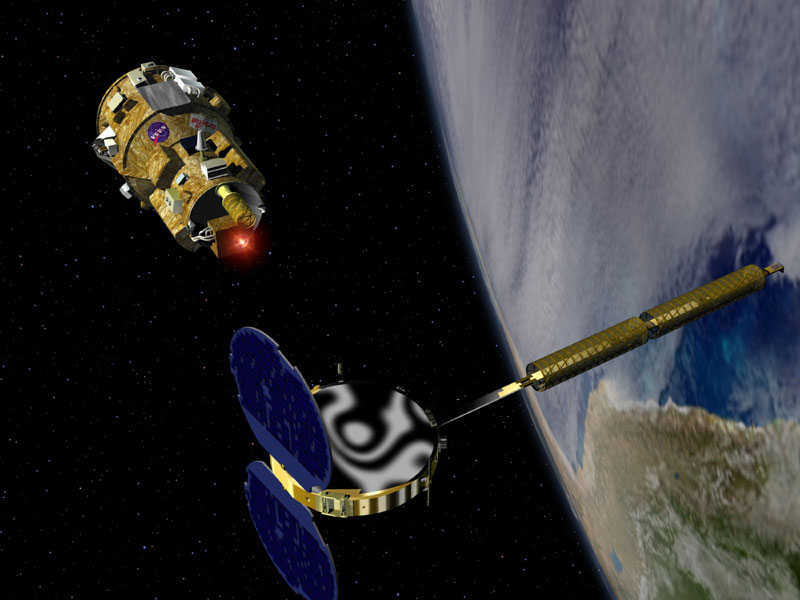Weather May Scrub Launch of NASA's DART Spacecraft

NASAresearchers are one day away from testing what they hope will be the spaceagency's first unmanned vehicle capable of meeting up with other orbitingspacecraft. That is, as long as the weather holds.
Launchofficials said Monday that there is a 90 percent chance weather violations couldscrub the Oct. 26 launch of DART, a spacecraft designed to seek out andrendezvous with a satellite in Earth orbit. If successful, DART'sflight could prove key technologies developed by NASA to build autonomous,rendezvous-ready spacecraft.
"We havelaunched on 90 percent chance of violation days before," NASA launch directorOmar Baez said during a prelaunch press conferencetoday at Vandenberg Air Force Base in California.
If weatherdoes scrub the launch, a second attempt could occur as soon as Thursday, headded.
DART, shortfor Demonstration of Autonomous Rendezvous Technology, is expected to launchfrom the air atop a four-stage Orbital Sciences Pegasus XL rocket at 2:13:20 p.m.EDT (1813:20 GMT) in a flight stagedfrom California's Vandenberg Air Force Base. A former passenger jet, StargazerL-1011, will carry the rocket into launch position 40,000 feet (12,192 meters) abovethe Pacific Ocean.
"We're runningon a lot of excitement...but we don't want to jeopardize all the money and effortinto this mission," said Jim Snoddy, DART project managerfrom NASA's Marshall Space Flight Center, of the $95 million mission. "We want tomake sure it goes safely."
NASAresearchers believe the autonomous capabilities tested by DART will lay thefoundation for future missions beyond Earth orbit, where an autopilot - insteadof real-time remote control - may be more preferable during dockings. Themission is cooperative effort between NASA researchers and the Orbital SciencesCorporation (OSC), which developed the spacecraft.
Get the Space.com Newsletter
Breaking space news, the latest updates on rocket launches, skywatching events and more!
"Whetheryou're going to the moon or Mars, you're always going to have to put thingstogether in space," Snoddy said.
Spaceflight sans humans
While DART's launch marks the first flight of a U.S.-builtunmanned rendezvous space vehicle, though the Russian Federal Space Agency'sProgress and Soyuz vehicles have docked autonomously with space stations foryears. Europe is also planning to launch the cargo ship Jules Verne, the firstof its Automated Transfer Vehicles (ATV) to the International Space Stationnext year.
"DARTcarries it to the next step," Snoddy said, adding thatonce the spacecraft launches, it will be function independent of any humanintervention. "We're automating everything from the ground operations to the flightoperations, and we don't heavy antennas or flight boxes."
At the heartof the DART mission is a device called an advanced video guidance sensor (AVGS),which combines advanced optical and electronic ranging systems to approach itssatellite target - the Multiple Paths Beyond Line-of-Site Communications(MUBLCOM) spacecraft launched in 1999.
A globalpositioning system (GPS) will also aid DART'srendezvous, and onboard software will test collision avoidance maneuvers, anddirect the spacecraft to fly circles around MUBLCOM. An onboard camera willhopefully catch images of the rendezvous.
"We've doneeverything we can on the ground," Snoddy said. "Thenext step is to take it into space."
Air-to-space rocket
It shouldtake DART and its Pegasus booster about 12 minutes to rocket into space oncetheir Stargazer mothership drops them 100 miles (160 kilometers)out over the Pacific Ocean.
Once inorbit, DART is programmed to begin using its GPS system to establish itslocation then fire three hydrazine thrusters to chase its target satellite. TheMUBLCOM spacecraft carries two sets of reflectors for DART to bounce ranginglasers off of, researchers said.
When DARTflies within 621 miles (1,000 kilometers) of MUBLCOM, it is expected to switchover to its AVGS navigation system and hopefully fly rings around thespacecraft, with its closest approaching reaching about 16 feet (5 meters)before backing out and making another pass. About 24 hours after launch, DART's onboard batteries should begin to expire and thespacecraft will fire its engines self-destruct reentry path to burn up in Earth'satmosphere.
After DART's flight, researchers hope to study the data and applyit to future technology shakedown missions, including automated dockingmissions.
"This technologywill become more important as we get farther away from Earth," Snoddy said.
Join our Space Forums to keep talking space on the latest missions, night sky and more! And if you have a news tip, correction or comment, let us know at: community@space.com.

Tariq is the Editor-in-Chief of Space.com and joined the team in 2001, first as an intern and staff writer, and later as an editor. He covers human spaceflight, exploration and space science, as well as skywatching and entertainment. He became Space.com's Managing Editor in 2009 and Editor-in-Chief in 2019. Before joining Space.com, Tariq was a staff reporter for The Los Angeles Times covering education and city beats in La Habra, Fullerton and Huntington Beach. In October 2022, Tariq received the Harry Kolcum Award for excellence in space reporting from the National Space Club Florida Committee. He is also an Eagle Scout (yes, he has the Space Exploration merit badge) and went to Space Camp four times as a kid and a fifth time as an adult. He has journalism degrees from the University of Southern California and New York University. You can find Tariq at Space.com and as the co-host to the This Week In Space podcast with space historian Rod Pyle on the TWiT network. To see his latest project, you can follow Tariq on Twitter @tariqjmalik.









